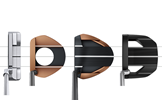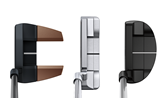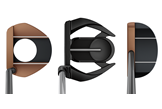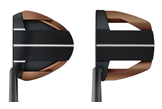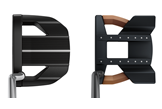Find your perfect putter alignment aid
Published: Last updated:
Long line? Short line? Three lines? No lines? There’s more to putter alignment aids than meets the eye…
Ping are primarily an engineering company, so they plough a ton of resources into researching golfers. It means the company’s 75-strong R&D team get to carry out loads of investigations to build what they refer to as their “foundation of knowledge”. The idea is that, over time, they’ll better understand every kind of golfer, which will help Ping create better products more suited to satisfying any player’s needs.
RELATED: Best Putting Mats
A recent Ping study into what features golfers use to align their putter threw up some interesting results, according to Dr Paul Wood, Ping’s VP of engineering. The study looked closely at why one alignment aid helps one player, but is seen by another as distracting.
The research has led to Ping now categorising its putters into four distinct alignment aid groups – and understanding the four categories can help you choose a new model that will help you hole more putts, more often. Some of the brand’s putter models fit into a single category whereas others, like the Ketsch, satisfy three. Here’s an explanation of each.
TESTED: Best Putter 2020
THE CLEAN TOP RAIL

Golfers who like a clean top rail use the perpendicular line created by the blade sat behind the ball to square up to their target. There’s plenty of Ping putters (Fetch, Valor and Wolverine) that combine a clean top rail design with other alignment features, but players who like models in this category will often find the extra cosmetic shapes or lines distracting.
Predominantly, think of the golfers who gravitate to this style of putter as liking simpler, traditional blade designs with less going on cosmetically and you won’t go far wrong.
Ping’s Dr Wood told us: “A lot of players who gravitate towards a blade want a clean, unbroken top rail – put anything on there and it messes with the player’s ability to align. These types of players are literally using the top edge to square the blade at address. There’s also an extreme category within this group – players who don’t want an alignment aid at all.”
RELATED: WITB – Andy Sullivan’s Ping clubs reviewed and tested
Ping models in this category
Heppler: Anser 2, Fetch, Piper C (and Armlock), Tyne 3, ZB3
Sigma 2: Anser, Arna, Fetch, Kushin C, Tyne, Tyne 4, Valor, Wolverine, ZB 2
A BALL-WIDTH FEATURE

Golfers who like a ball-width feature do so because they like to frame the ball while lining up to putt. There are tons of putters out there that have a feature to frame the ball at address, and while some do it subtly, others are much more explicit.
“This kind of player wants lines to indicate where the outer edges of the ball should be in relation to the putter’s body, like tram lines running straight from the putter’s head out to the edges of the golf ball that’s sat in front of it,” according to Dr Wood. The putter may have a clean top rail, but golfers aren’t using it to align.
Some Ping blade putters of the past have had ball-width features, and combined it with a clean top rail and possibly even a central sightline, but this category of golfer doesn’t use them to align – they simply use the ball-width feature.
Ping models in this category
Heppler: Fetch, Ketsch, Piper C (and Armlock), Tomcat 14, Tyne 3
Sigma 2: Fetch, Tyne, Tyne 4, Wolverine H
What is putter toe hang? And why is it important?
A SIGHTLINE THAT RUNS TO THE BALL

Ping’s research highlighted how the company didn’t have many options within this category, which ultimately led to the development of the Ketsch.
A sightline like this leads the eye all the way to the back of the ball, and at TG we’ve always felt it gives the impression of hitting a nail in with a hammer when putting. The alignment feature doesn’t have to be a line – it can be another design – but explicitly this style of putter doesn’t have a top rail.
Ping’s research asked golfers which alignment style they felt they could line up easily, and Dr Wood says: “The research showed a really good match between players who described a putter matching their eye, and aligning consistently correctly with those models.” So there’s a real link between finding a putter that’s easy to align and putting well with it.
Ping models in this category
Heppler: Floki, Ketsch
A LONG SIGHTLINE

Typically, this feature is only really found on mallet-style putters, because blades don’t have the body width to create a long sight line.
It’s not a hard and fast rule, but it often tends to be less skilled putters who like this style of alignment aid most. Dr Wood told us: “There’s a real trend of more skilled players wanting fewer alignment features.” Sort of makes sense as the better you are at lining up, the less help you need.
There’s a reason most beginners don’t pick up traditional blades with no sightlines; they’re not so easy to line up. It’s natural, then, for less skilled and less confident golfers to go for wider body, longer sightline models because there’s more insurance. Mallets are more stable and forgiving, but you also get more help lining up, too.
Ping models in this category
Heppler: Tomcat 14
Sigma 2: Arna, Valor, Wolverine
WATCH: Best 2020 Putter video

Review written by: Simon Daddow
Job title: Today’s Golfer – Equipment Editor

